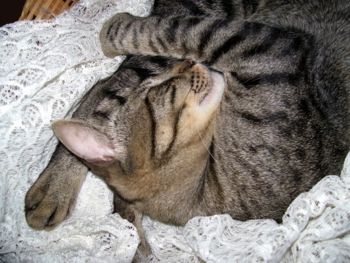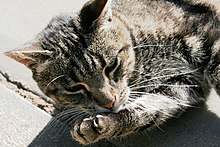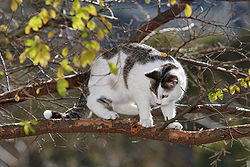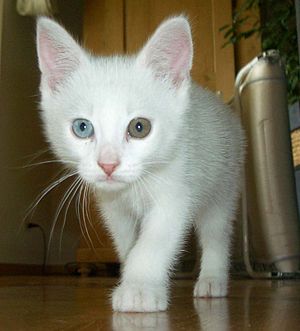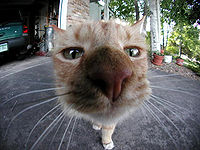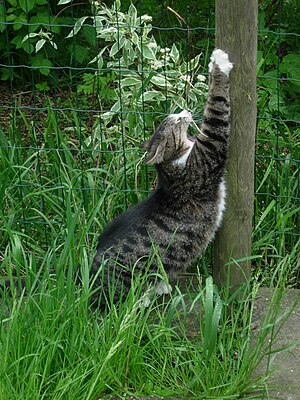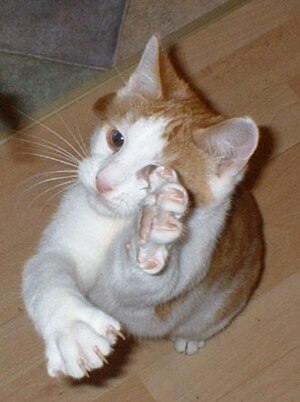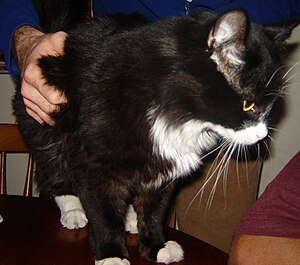Cat: Difference between revisions
imported>Nancy Sculerati MD No edit summary |
imported>Nancy Sculerati MD |
||
| Line 31: | Line 31: | ||
===Physical features=== | ===Physical features=== | ||
[[Image:Cat cleaning itself.jpg|thumb|220px|A cat grooming itself]] | [[Image:Cat cleaning itself.jpg|thumb|220px|A cat grooming itself]] | ||
Cats generally weigh between 2.5 and 7 kg (5.5–16 pounds). Unlike dogs or horses, there is not a tremendous range in size between healthy weight adults. However, there is some size variations among | Cats generally weigh between 2.5 and 7 kg (5.5–16 pounds). Unlike dogs or horses, there is not a tremendous range in size between healthy weight adults. However, there is some size variations among breeds. The [[Maine Coon]] is the largest of the domestic cats, and can exceed 11.3 kg (25 pounds) in lean weight. | ||
Domestic cats tend to live longer if they are not permitted to go outdoors (reducing the risk of injury from fights or accidents and exposure to diseases) and if they are [[spaying and neutering|spayed or neutered]]. In captivity, indoor cats typically live 14 to 20 years, with 36 years being the record for the oldest pet cat. age .<ref>{{cite web | title=Feline Statistics | url=http://www.pawsonline.info/feline_statistics.htm | accessdate=August 15 | accessyear=2005 }}</ref> | Domestic cats tend to live longer if they are not permitted to go outdoors (reducing the risk of injury from fights or accidents and exposure to diseases) and if they are [[spaying and neutering|spayed or neutered]]. In captivity, indoor cats typically live 14 to 20 years, with 36 years being the record for the oldest pet cat. age .<ref>{{cite web | title=Feline Statistics | url=http://www.pawsonline.info/feline_statistics.htm | accessdate=August 15 | accessyear=2005 }}</ref> | ||
Revision as of 21:55, 13 December 2006
| Cat | ||||||||||||||||
|---|---|---|---|---|---|---|---|---|---|---|---|---|---|---|---|---|
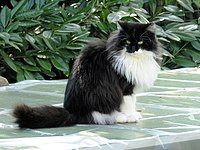 | ||||||||||||||||
| Conservation status | ||||||||||||||||
| Scientific classification | ||||||||||||||||
| ||||||||||||||||
| Trinomial name | ||||||||||||||||
| Felis silvestris catus (Linnaeus, 1758) |
Cats
are in a class by themselves when it comes to the sorts of animals that we have domesticated. One of the most unusual features of the house cat has to do with what we might call "lifestyle", and has to do with what is often referred to as the cat's aloofness. The forebear of the housecat, the African wild cat, appears to have been a solitary rather than a social animal. Unlike wolves (and horses) who normally live in packs (or herds) as adults, and whose domestication hinged on prompting them to recognize us as a sort of group leader; cats are not partial to organization. The technical word for a group of cats is a clowder, and it certainly does not get much use in general conversation. Cats have been brought into the sphere of human company from a solitary, rather than social, realm in nature. There is no doubt that the house cat has been changed over the thousands of generations the species has lived with and around us (see the section on Cat Colonies below)- but there is also no doubt that the cat has never been, and is not now, inclined to accept orders from any kind of group leader. The only homage to the head of the household that cats pay is in the form of headless rodents deposited at the front door, and not because they were asked to provide them!
The domestic life of cats
How did such an animal end up being adopted into our homes? The most accepted answer has to do with the cat's efficiency at rodent extermination. The domestic cat, unlike many predators, does not hunt and kill only when hungry. Instead, most cats cannot resist the lure of moving prey and will stalk a scampering mouse or fluttering bird with the sort of focused dedication that XXX.
Characteristics
Physical features
Cats generally weigh between 2.5 and 7 kg (5.5–16 pounds). Unlike dogs or horses, there is not a tremendous range in size between healthy weight adults. However, there is some size variations among breeds. The Maine Coon is the largest of the domestic cats, and can exceed 11.3 kg (25 pounds) in lean weight.
Domestic cats tend to live longer if they are not permitted to go outdoors (reducing the risk of injury from fights or accidents and exposure to diseases) and if they are spayed or neutered. In captivity, indoor cats typically live 14 to 20 years, with 36 years being the record for the oldest pet cat. age .[1]
Some such benefits are neutered male cats cannot develop testicular cancer, spayed female cats cannot develop ovarian cancer, and both have a reduced risk of mammary cancer.[2] In contrast, feral cats living in modern urban environments often live only two years, or less. Feral cats in maintained colonies can live much longer; the British Cat Action Trust reported a 19-year-old feral female. The oldest feral cat was "Mark" who was maintained by the British charity Cats Protection and who reached 26 years of age.
Cats are athletic. Fast sprinters, they are capable of reaching speeds of about 50 km/h (about 30 mph) for short distances. They can often jump vertically up a fence or wall over 2 meters (over 7 feet) from stationary. The domestic cat is one of the few four-legged animals that do not possess rigid collarbones [3]. This allows a cat to fit through an opening about the size of its head.
Ears
Due to their crepuscular nature,
The normal body temperature of a cat is between 38 and 39 °C (101 and 102.2 °F).[3] A cat is considered febrile (hyperthermic) if it has a temperature of 39.5 °C (103 °F) or greater, or hypothermic if less than 37.5 °C (100 °F). For comparison, humans have a normal temperature of approximately 36.8 °C (98.2 °F). A domestic cat's normal heart rate ranges from 140 to 220 beats per minute, and is largely dependent on how excited the cat is. For a cat at rest, the average heart rate should be between 150 and 180 bpm, about twice that of a human.
Legs
Cats, like dogs, are digitigrades: they walk directly on their toes, the bones of their feet making up the lower part of the visible leg. Cats are capable of walking very precisely, because like all felines they directly register; that is, they place each hind paw (almost) directly in the print of the corresponding forepaw, minimizing noise and visible tracks. This also provides sure footing for their hind paws when they navigate rough terrain.
Unlike dogs, cats walk by moving both legs on one side and then both legs on the other, a type of pacing gait.
Like all members of family felidae, with the exception of the cheetah, house cats have retractable claws. In their normal, relaxed position the claws are sheathed with the skin and fur around the toe pads. This keeps the claws sharp by preventing wear from contact with the ground and allows the silent stalking of prey. The claws on the forefeet are usually sharper than those on the hind feet. Cats can extend their claws voluntarily on one or more paws at will. Cats may extend their claws in hunting or self-defense, climbing, "kneading", or for extra traction on soft surfaces (bedspreads, thick rugs, etc.).
Most cats have 4 claws at the rear and 5 at their front paws. But because of an allele in the gene pool, cats are prone to polydactyly, and some have 6 or 7 toes. One breed of cat, the Maine Coon, has a particularly high rate of polydactyly.
Perching and falling
Most breeds of cat have a noted fondness for settling in high places, or perching.
During a fall, a cat can reflexively twist its body and right itself using its acute sense of balance and flexibility. [4] This is known as the cat's "righting reflex." It always rights itself in the same way, provided it has the time to do so during a fall. Thus, high (multi-story) falls can be less dangerous to them than those of only a few meters. Many cases are known of cats falling from substantial heights (5 to 10 stories) and surviving almost unscathed. Contrary to popular belief cats without a tail also have this ability, since a cat mostly moves its hindlegs and relies on conservation of angular momentum to set up for landing, and the tail is in fact little used for this feat.[5]
Senses
Measuring the senses of any animal can be difficult because there is usually no explicit communication (e.g., reading aloud the letters of a Snellen chart) between the subject and the tester.
While a cat's senses of smell may not be as keen as, say, that of a mouse, it is superior in many ways to those of humans. These along with the cat's highly advanced hearing, eyesight, taste, and touch receptors make the cat extremely sensitive among mammals.
Sight
Testing indicates that a cat's vision is superior at night in comparison to humans, and inferior in daylight. Cats, like dogs and many other animals, have a tapetum lucidum that reflects extra light to the retina. While this enhances the ability to see in low light, it appears to reduce net visual acuity, thus detracting when light is abundant. In very bright light, the slit-like iris closes very narrowly over the eye, reducing the amount of light on the sensitive retina, and improving depth of field. The tapetum and other mechanisms give the cat a minimum light detection threshold up to seven times lower than that of humans. Variation in color of cats' eyes in flash photographs is largely due to the interaction of the flash with the tapetum.
Average cats have a visual field of view estimated at 200°, versus 180° in humans, with a binocular field (overlap in the images from each eye) narrower than that of humans. As with most predators, their eyes face forward, affording depth perception at the expense of field of view. Field of view is largely dependent upon the placement of the eyes, but may also be related to the eye's construction. Instead of the fovea which gives humans sharp central vision, cats have a central band known as the visual streak. Cats can apparently differentiate among colors, especially at close range, but without appreciable subtlety.
Cats have a third eyelid, the nictitating membrane, which is a thin cover that closes from the side and appears when the cat's eyelid opens. This membrane partially closes if the cat is sick; although in a sleepy, content cat this membrane is often visible. If a cat chronically shows the third eyelid, it should be taken to a veterinary surgeon.
Cats have a wide variation in eye color, the most typical colors being golden, green and orange. Blue eyes are usually associated with the Siamese breed, but they are also found in white cats. If a white cat has two blue eyes, it is oftentimes deaf; however, orange eyes usually indicate the cat is free of hearing problems. White cats having one blue and one other-colored eye are called "odd-eyed" and may be deaf on the same side as the blue eye.[6] This is the result of the yellow iris pigmentation rising to the surface of only one eye, as blue eyes are normal at birth before the adult pigmentation has had a chance to express itself in the eye(s).
Hearing
Humans and cats have a similar range of hearing on the low end of the scale, but cats can hear much higher-pitched sounds, up to 64,000 kHz, which is 1.6 octaves above the range of a human, and even 1 octave above the range of a dog.[7] When listening for something, a cat's ears will swivel in that direction; a cat's ear flaps (pinnae) can independently point backwards as well as forwards and sideways to pinpoint the source of the sound. Cats can judge within three inches (7.5 cm) the location of a sound being made one yard (approximately one meter) away - this can be useful for localizing prey etc.
Smell
Cats have twice as many smell-sensitive cells in their noses as people do, which means they can smell things we are not even aware of. Cats also have a scent organ in the roof of their mouths called the vomeronasal, or Jacobson's organ, which causes cats to become extremely sensitive towards open flames, fire, or burning objects. When a cat wrinkles its muzzle, lowers its chin, and lets its tongue hang a bit, it is opening the passage to the vomeronasal. This is called gaping, "sneering", or "flehming". Gaping is the equivalent of the Flehmen response in other animals, such as dogs, horses and big cats.
Touch
Cats generally have about a dozen whiskers in four rows on each upper lipTemplate:Fact, a few on each cheek, tufts over the eyes and bristles on the chin. Whiskers may also be found on the cat's inner "wrists", and there are similar hairs which make up the cat's eyebrows. The Sphynx (a nearly hairless breed) may have full length, short, or no whiskers at all.
Whiskers (called vibrissae) can aid with navigation in the dark. Whiskers may detect very small shifts in air currents, enabling a cat to know it is near obstructions without actually seeing them. The upper two rows of whiskers can move independently from the lower two rows for even more precise measuring.
The whiskers also spread out roughly as wide as the cat's body making it able to judge if it can fit through an opening.
Whiskers are also an indication of the cat's attitude. Whiskers point forward when the cat is inquisitive and friendly, and lie flat on the face when the cat is being defensive or aggressive.
Cats also have a number of reinforced hairs similar to whiskers on other parts of their bodies: over the eyes, on the chin and at the back of the legs. [4]
Taste
Cats cannot taste sugary foods due to a faulty sweet receptor gene.
Communication
Hunting and diet
Even the most well-fed of domestic cats will hunt and kill birds, mice, rats and other small animals when given the opportunity. They often present such trophies to their owner. The motivation is not entirely clear, but friendly bonding behaviors are often associated with such an action. Due to their ceaseless hunting, cats are hazardous to small animals, including locally endangered bird species. In some cases, cats have contributed to or caused extinctions -— for example, see the case of the Stephens Island Wren.
In captivity, cats cannot live on an unsupplemented vegetarian diet because they cannot synthesize several nutrients they need and that are absent or rare in plant food. This applies mainly to taurine, vitamin A (cats cannot convert the pro-vitamin A that is abundant in plants to vitamin A proper) and to certain fatty acids. The absence of taurine causes the cat's retina to slowly degenerate, causing eye problems and (eventually) irreversible blindness. This condition is called central retinal degeneration (CRD). Cow's milk is a poor source of taurine and adult cats are generally lactose intolerant. Lactose-free milk is perfectly safe, but still not a substitute for meat.
Some vegetarians, however, feed their cats a vegetarian diet, with a supplement containing these specific nutrients and others tailored to meet the needs of cats[8]. Vegan pre-supplemented kibble is also available[9].
Some houseplants are harmful to cats. The leaves of the Easter Lily can cause permanent and life-threatening kidney damage to cats. Philodendron are also poisonous to cats. Cat Fancy has a full list of plants harmful to cats.
Some cats have a fondness for catnip. While they generally do not consume it, they will often roll in it, paw at it, and occasionally chew on it (as catnip is sensed by the cat's Vomeronasal organ). The effect is usually relatively short, lasting for only a few minutes. After two hours or less, susceptible cats gain interest again. Several other species of plants cause this effect, to a lesser degree.
Because of their small size, domestic cats pose little danger to humans — the main hazard is the possibility of infection (e.g., cat scratch disease, or, rarely, rabies) from a cat bite or scratch.
Hygiene
Cats are known for their fastidious grooming. They groom themselves by licking their fur, employing their hooked pappilae and saliva. Their saliva is a powerful cleaning agent, but it can provoke allergic reactions in humans. Some people who are allergic to cats—typically manifested by hay fever, asthma or a skin rash —quickly acclimate themselves to a particular animal and live comfortably in the same house with it, while retaining an allergy to cats in general.Template:Fact Many cats also enjoy grooming humans or other cats. Some cats occasionally regurgitate hair balls of fur that have collected in their stomachs as a result of their grooming. Longhair cats are more prone to this than shorthairs. Hairballs can be prevented with certain cat foods and remedies that ease elimination of the hair and regular grooming of the coat with a comb or stiff brush. Cats expend nearly as much fluid grooming as they do urinating.
Indoor cats may be provided a litter box containing sand or similar material (litter). This arrangement serves the same purpose as a toilet for humans. It should be cleaned daily and changed often (depending on the number of cats in a household and the type of litter; clumping litter stays cleaner longer, but has been reported to cause health problems in some cats. [10]) A litterbox is recommended for indoor-outdoor cats as well. Litterboxes may pose a risk of toxoplasmosis transmission to susceptible pregnant women and immuno-compromised individuals. Transmission risk may be reduced by daily litterbox cleaning by someone other than child-bearing women.
Some cats have been succesfully toilet trained, eliminating the litterbox and its attendant expense and smell. Training involves at least two or three weeks of incremental moves, such as moving and elevating the litterbox until it is near the toilet. For a short time, an adapter, such as a bowl or small box, may be used to suspend the litter above the toilet bowl. When training is complete, the cat uses the toilet by perching over the bowl. [11]
Indoor cats will also benefit from being provided with a scratching post so they are less likely to ruin furniture with their claws.[12] No matter how well used a scratching post might be to some cats, that are individuals who are not . Nails can be trimmed, as with a small pair of electrical dikes (ie, cutting pliers), but care should always be taken to avoid cutting a vein in the quick of the claw.
Declawing
Declawing is a major surgery known as onychectomy, performed under anesthesia, that removes the tip of each digit (from the first knuckle out) of the cat's forepaws (and sometimes the hind paws). A declawed cat may have an increased risk of infection and life-long discomfort in its paws. This surgery is not recommended for an adult animal and is considered an act of animal cruelty in some countries (see below).
People generally have cats declawed to prevent them from hunting and from damaging furniture. Rarely, vicious cats are declawed. In the United States, some landlords require that tenants' cats be declawed.
Veterinarians are generally critical of the procedure and some refuse to perform it because the absence of claws in a cat:
- Deprives it of its main defense abilities, including escaping from predators by climbing trees;
- Impairs its stretching and exercise habits, leading to muscle atrophy;
- Compromises its ability to balance on thin surfaces such as railings and fence tops, leading to injury from falls;
- Can cause insecurity and a subsequent tendency to bite.
Most cats dislike immersion in water; one major exception is the Turkish Van breed which has an unusual fondness for water [5]. Abyssinians are also reported to be more tolerant of water than most cats.
Reproduction and genetics

Cats are seasonally polyestrous, which means they may have many periods of heat over the course of a year. A heat period lasts about 4 to 7 days if the female is bred; if she is not, the heat period lasts longer.
The male cat's penis has spines which point backwards. Upon withdrawal of the penis, the spines rake the walls of the female's vagina. The female needs this stimulation for ovulation to begin. Because this does not always occur, females are rarely impregnated by the first male with which they mate. Furthermore, cats are superfecund; that is, a female may mate with more than one male when she is in heat, meaning different kittens in a litter may have different fathers.
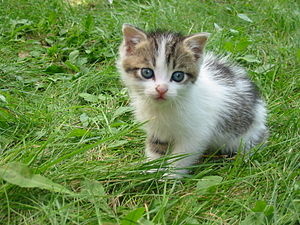
The reproduction process can be very loud, as both cats vocalize loudly. If one is not used to the sounds of cats mating, it sounds very much like a cat fight.
The gestation period for cats is approximately 63-65 days. The size of a litter averages three to five kittens, with the first litter usually smaller than subsequent litters. Kittens are weaned at between six and seven weeks, and cats normally reach sexual maturity at 4-10 months (females) and to 5-7 months (males).
Cats are ready to go to new homes at about 12 weeks old (the recommended minimum age by Fédération Internationale Féline), or when they are ready to leave their mother. Cats can be surgically sterilized (spayed or neutered) as early as 6-8 weeks to limit unwanted reproduction. This surgery also prevents undesirable sex-related behavior, such as territory marking (spraying urine) in males and yowling (calling) in females. If an animal is neutered after such behavior has been learned, however, it may persist.
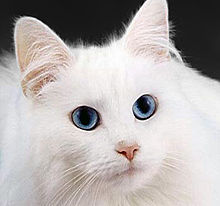
There are several genes responsible for the hair color identified. The combination of them gives different phenotypes. See Cat coat genetics.
Features like hair length, lack of tail or presence of a very short tail (bobtail cat) are also determined by single alleles and modified by polygenes.
The Cat Genome Project, sponsored by the Laboratory of Genomic Diversity at the U.S. National Cancer Institute Frederick Cancer Research and Development Center in Frederick, Maryland, focuses on the development of the cat as an animal model for human hereditary disease, infectious disease, genome evolution, comparative research initiatives within the family Felidae, and forensic potential.
nd peculiar kittens how to hunt by demonstrating what the point of it all is).
Despite its reputation as a solitary animal, the domestic cat is social enough to form colonies, but does not attack in groups as do lions. Some breeds like bengal, ocicat and manx are very social, but these breeds are exceptions. While each cat holds a distinct territory (sexually active males having the largest territories, and neutered cats having the smallest), there are "neutral" areas where cats watch and greet one another without territorial conflicts. Outside these neutral areas, territory holders usually aggressively chase away stranger cats, at first by staring, hissing, and growling, and if that does not work, by short but noisy and violent attacks. Fighting cats make themselves appear more impressive and threatening by raising their fur and arching their backs, thus increasing their visual size. Cats also exhibit this behavior while playing. Attacks usually comprise powerful slaps to the face and body with the forepaws as well as bites, but serious damage is rare; usually the loser runs away with little more than a few scratches to the face, perhaps the ears. Normally, serious negative effects will be limited to possible infections of the scratches and bites; though these have been known to sometimes kill cats if untreated. Sexually active males will usually be in many fights during their lives, and often have decidedly battered faces with obvious scars and cuts to the ears and nose. Not only males will fight; females will also fight over territory or to defend their kittens, and even neutered cats will defend their (smaller) territories aggressively.
Feral cats

Feral cats may live alone, but most are found in large groups called feral colonies with communal nurseries, depending on resource availability. Urban areas in the developed world are not friendly, nor adapted, environments for cats; most domestic cats are descended from cats in desert climates and were distributed throughout the world by humans. Nevertheless, some feral cat colonies are found in large cities, e.g., around the Colosseum and Forum Romanum in Rome.
However, there are thousands of volunteers and organizations that trap these unadoptable feral felines, spay or neuter them, immunize the cats against rabies and feline leukemia, and treat them with long-lasting flea products. Before release back into their feral colonies, the attending veterinarian often nips the tip off one ear to mark the feral as spayed/neutered and inoculated, as these cats will more than likely find themselves trapped again. Volunteers continue to feed and give care to these cats throughout their lives, and not only is their lifespan greatly increased, but behavior and nuisance problems, due to competition for food, are also greatly reduced. In time, if an entire colony is successfully spayed and neutered, no additional kittens are born and the feral colony disappears. Many hope to see an end to urban feral cat colonies through these efforts.
Overpopulation
According to the Humane Society of the United States, 3-4 million cats and dogs are euthanized each year in the United States and many more are confined to cages in shelters because there are significantly more animals being born than there are homes. Spaying or neutering pets helps keep the overpopulation down. [6] Local humane societies, SPCA's and other animal protection organizations urge people to spay or neuter their pets and to adopt animals from shelters instead of purchasing them.
Varieties of domestic cat

The list of cat breeds is quite large: most cat registries recognize between 35 and 70 breeds of cats, and several more are in development, with one or more of new breeds being recognized each year on average, having distinct features and heritage. The owners and breeders of show cats compete to see whose animal bears the closest resemblance to the "ideal" definition of the breed (see selective breeding). Due to common crossbreeding in populated areas, many cats are simply identified as belonging to the homogeneous breeds of domestic longhair and domestic shorthair, depending on their type of fur. In the United Kingdom and Australia, non-purebred cats are referred in slang as moggies (derived from "Maggie", short for Margaret, reputed to have been a common name for cows and calves in 18th-century England and latter applied to housecats during the Victorian era).[13] In the United States, a non-purebred cat is sometimes referred to in slang as a barn or alley cat, even if it is not a stray.
Cats come in a variety of colors and patterns. These are physical properties and should not be confused with a breed of cat.
Household cats are divided into:
Coat patterns
Cat coat genetics can produce a variety of coat patterns. Some of the most common are:
- Bicolor, Tuxedo and Van
- This pattern varies between the tuxedo cat which is mostly black with a white chest, and possibly markings on the face and paws/legs, all the way to the Van pattern (so named after the Lake Van area in Turkey, which gave rise to the Turkish Van breed), where the only colored parts of the cat are the tail (usually including the base of the tail proper), and the top of the head (often including the ears). There are several other terms for amounts of white between these two extremes, such as harlequin or jellicle cat. Bicolor cats can have as their primary (non-white) color black, red, any dilution thereof and also tortoiseshell (see below for definition).

- Tabby cat
- Striped, with a variety of patterns. The classic "blotched" tabby (or "marbled") pattern is the most common and consists of butterflies and bullseyes. The "mackerel" or "striped" tabby is a series of vertical stripes down the cat's side (resembling the fish). This pattern broken into spots is referred to as a "spotted" tabby. Finally, the tabby markings may look like a series of ticks on the fur, thus the "ticked" tabby, which is almost exclusively associated with the Abyssinian breed of cats. The worldwide evolution of the cat means that certain types of tabby are associated with certain countries; for instance, blotched tabbies are quite rare outside NW Europe, where they are the most common type.
- Tortoiseshell and Calico
- This cat is also known as a Calimanco cat or Clouded Tiger cat, and by the nickname "tortie". In the cat fancy, a tortoiseshell cat is randomly patched over with red (or its dilute form, cream) and black (or its dilute blue) mottled throughout the coat. Additionally, the cat may have white spots in its fur, which will make it a "tortoiseshell and white" cat or, if there is a significant amount of white in the fur and the red and black colors form a patchwork rather than a mottled aspect, the cat will be called a "calico". All calicos are tortoiseshell (as they carry both black and red), but not all tortoiseshells are calicos (which requires a significant amount of white in the fur and patching rather than mottling of the colors). The calico is also sometimes called a ";tricolor cat".The Japanese refer to this pattern as mi-ke (meaning "triple fur"), while the Dutch call these cats a lapjeskat (meaning "patches cat"). A true tricolor must consist of three colors: a reddish color, dark or light; white; and one other color, typically a brown, black or blue, as described by American breeder Barbara French, writing for the Cat Fanciers community [14]. Both tortoiseshell and calico cats are typically female because the coat pattern is the result of differential X chromosome inactivation in females (which, as with all normal female mammals, have two X chromosomes). Those male tortoiseshells that are created are usually sterile; conversely, cats where the overall color is ginger (orange) are commonly male (roughly in a 3:1 ratio). In a litter sired by a ginger tom, the females will be tortoiseshell or ginger. See "Tortoiseshell and Tricolour Cats" for an extensive genetic explanation for tricolor cats, and detailing the possible combinations of coloring.[15]
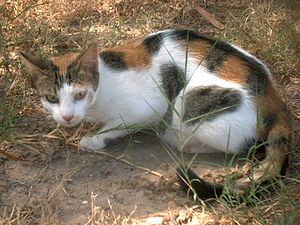 A female Calico cat.
A female Calico cat. - ColorpointFile:IMG 4115.JPGA flame point Siamese mix.
- The colorpoint pattern is most commonly associated with Siamese cats, but also may appear in any domestic cat. A colorpoint cat will have dark colors on the face, ears, feet, and tail, with a lighter version of the same color on the rest of the body and possibly some white. The exact name of the colorpoint pattern depends on the actual color, so there are seal points (dark grey), chocolate points (dark brown), flame points (dark orange), and tortie points. It should also be noted that colorpoint cats tend to darken with age, and the fur over a significant injury may sometimes darken or lighten depending on circumstances due to the fact that pigment synthesis in the fur is temperature-sensitive.
Body types
Cats can also come in several body types, ranging between two extremes:
- Oriental
- Not a specific breed, but any cat with an elongated slender build, almond-shaped eyes, long nose, large ears (the Siamese and oriental shorthair breeds are examples of this).
- Cobby
- Any cat with a short, muscular and compact build, roundish eyes, short nose, and small ears. The Persian breed is a prime example of a cobby cat.
References
- ↑ Feline Statistics. Retrieved on August 15, 2005.
- ↑ Spay and Neuter Your Pet Cats. Retrieved on August 8, 2005.
- ↑ Normal Values For Dog and Cat Temperature, Blood Tests, Urine and other information in ThePetCenter.com. Retrieved on August 8, 2005.
- ↑ Falling Cats. Retrieved on October 24, 2005.
- ↑ HOW DOES A CAT ALWAYS LAND ON ITS FEET ?
- ↑ White Cats, Eye Colours and Deafness. Retrieved on 2006-09-05.
- ↑ Strain, G.M., How Well Do Dogs and Other Animals Hear?
- ↑ Vegan Society: Cats.
- ↑ Amì: maker of vegan kibble for cats.
- ↑ Suspected bentonite toxicosis in a cat from ingestion of clay cat litter. Retrieved on September 10, 2005.
- ↑ Cat toilet-training. Retrieved on August 8, 2005.
- ↑ Scratching or clawing in the house. Retrieved on August 14, 2005.
- ↑ "Moggie" definition question and answer Worldwidewords.org. URL Accessed June 14, 2006.
- ↑ Torties, Calicos and Tricolor Cats. Retrieved on October 24, 2005.
- ↑ White Cats, Eye Colours and Deafness. Retrieved on August 8, 2005.
See also
Template:Wikibooks Template:Wiktionarypar Template:Wiktionarypar Template:Wiktionarypar
- Felidae
- Big cat
- Cat body language
- Catnip
- Cat flap
- Cat Fanciers' Association
- Cats in ancient Egypt
- Kitten
- List of historical cats
- List of fictional cats
- Polydactyl cat (extra toes)
- Cat types
- Cat breeds
External links
Template:Link FA Template:Link FA Template:Link FA Template:Link FA Template:Link FA Template:Link FA
als:Hauskatze ar:قطة an:Gato ast:Gatu bm:Jakuma zh-min-nan:Niau bo:ཞི་མི་ br:Kazh bg:Котка ca:Gat cs:Kočka domácí cy:Cath da:Kat de:Hauskatze et:Kass el:Γάτα es:Felis silvestris catus eo:Kato fr:Chat gl:Gato km:ឆ្មា ko:고양이 io:Kato id:Kucing ia:Catto domestic is:Köttur it:Felis silvestris catus he:חתול jv:Kucing la:Felis catus lv:Kaķis lb:Hauskaz lt:Katė hu:Macska mg:Saka mi:Ngeru ms:Kucing nl:Kat ja:ネコ no:Tamkatt nrm:Cat ug:مۈشۈك nds:Katt pl:Kot domowy pt:Gato doméstico ro:Pisică ru:Кошка st:Katse simple:Cat sk:Mačka domáca sl:mačka sr:Мачка fi:Kesykissa sv:Katt th:แมว vi:Mèo chr:ᏪᏌ tr:Kedi wa:Tchet zh:猫
